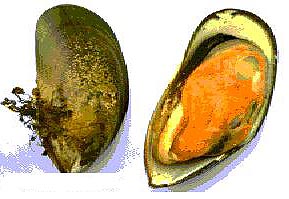Mussels are among the commonest sea shells. The dead shells litter the seashore while the living ones cluster together in rock crevices, on piers and wooden piles, even on ropes and mooring chains which hang in the water for a long time.
The blue-black shells are easy to recognise both by their
colour and by their shape which is rather wedge-like, pointed at the front end
and rounded at the back. Mussel eggs are released into the water in spring. They
hatch into tiny larvae which do not have shells, but swim freely in the water.
After a few weeks, the larva develops a double shell and, if it is lucky,
arrives on some firm support-a piece or wood or almost anything solid. It
wanders around a little until it finds a place to settle. Then the little mussel
spins a mass of strong, brown threads called a byssus and uses these to
tie it self firmly to support.

If all goes well, it will spend the rest of its life there. If strong waves knock it off later, a mussel may still be able to survive somewhere else. After the byssus has been broken, it can use its small foot to move around on the sea bed to find another anchoring place. Mussels are filter feeders and sieve enormous quantities of water for food, thousand of gallons in the course of the year. They can live in the area between the tides. At the ebb, they simply close their shells and wait until the water comes back again. The further up the shore the mussels live, the more time they spend out of the water and the less time they have to feed. Therefore they grow rather slowly.
Most of our mussels live below the reach of the tide and can keep feeding all the time so that they grow much faster. Mussel are very good to eat and are caught in enormous numbers. The principal fisheries are in sheltered estuaries such as Cromane, Wexford, Mornington and Dundalk Bay. At Mornington, the fisherman use long-handled rakes to collect them from the mussel beds. In the other fisheries, a dredge with a net attached hauled by motor boat.
In some years there are plenty of young or spat and two or three years later there will be plenty of mussels for fishermen. Quite often spat are scarce and the catch can be greatly improved by moving small mussels either from between the tidemarks where they grow slowly or from the open sea to the fishing grounds where there is much more food for them. That is one form of "mussel farming". Another is to build special supports for the young mussels in places where there is good food, but no room for them to settle.
